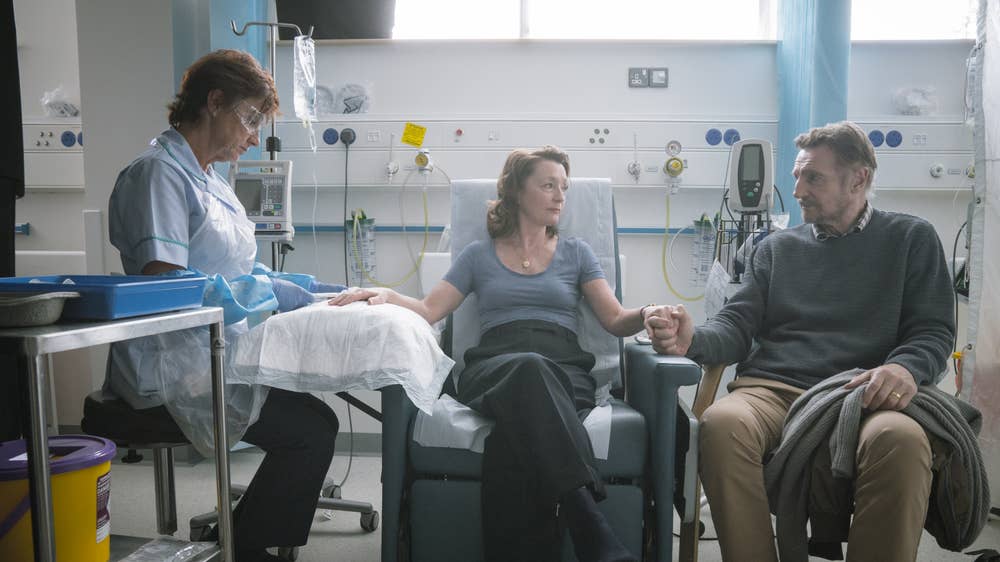ORDINARY LOVE is anything but “ordinary”. This is an emotionally elegant story and film that is told with the quiet beauty of simplicity and truth. This is life. This is marriage. This is love; love in the deepest and truest sense of the word.

Stripped back to its purest essence, directors Lisa Barros D’sa and Glenn Leyburn allow the effortless casual comfortability that Liam Neeson and Lesley Manville bring to the roles of Tom and Joan shine as the pair embrace the realism and naturalism of Owen McCafferty’s story, a story based on his own experiences. They are magic onscreen.
A decades-married couple, Tom and Joan do indeed have an “ordinary life.” They take daily walks together, shop together, needle each other with knowing jovial barbs that only come with sharing a lifetime together. Their deep affection for each other is evident with every glance, every word, and intimacy is tender yet heated. They are comfortable with each other at this stage of their lives, happy, content. Their home is modest but nicely comported; dated, but warm, and well suited to them. But that is what stands out. They do not socialize. They appear to not have close friends. They have a lone goldfish in a large aquarium who is diligently tended to by Tom. We learn that they had a daughter who passed. We don’t know the circumstances of her death, but it is clear that with her passing, Tom and Joan changed and became each other’s everything, shutting out the world. Their life is their life with seemingly no outside influences; that is, until Joan finds a lump in her breast.

Bookended by Christmases, over the course of a year we see Joan and Tom go through the rigors of tests, diagnoses, chemo, surgeries, and the accompanying physical horrors suffered by Joan – the hair loss, the nausea and vomiting, freezing body temperatures. And through it all, Tom is by her side be it in the hospital, holding a bucket for her to be sick, and in one of the most poignant moments of the film, shaving her scalp and removing what is left of her ever-thinning hair. The authenticity and truth from a medical and emotional standpoint is a testament not only to D’Sa and Leyburn but Manville’s performance. We are experiencing all of this with Joan.

Key to ORDINARY LOVE is that D’Sa and Leyburn never sensationalize or over-dramatize the disease. Everything is presented and played out with the subtleties of day-to-day life. Particularly effective is the dialogue and interplay between Tom and Joan and the normalcy between them no matter the adversity of the situation. Having personally witnessed and experienced similar, the attitude and truth that “life goes on” resonates deeply.
The quiet elegance and sensitivity is what drives the film and allows us to embrace this couple and the challenge they are facing together without histrionics and “woe is me” tears and whining. They look at life as it is. There are no rose-colored glasses either. Life is what it is and you deal with it. The calm of both characters is beautiful.

Visually, the film is also simplistic in its design, clean, precise, elegant. The Thompson home is comfortable. Production designer Nigel Pollock creates a world of walnut wood tones with the golden warmth of Christmas tree lights enveloping the couple like a blanket, cocooning them as if in a time capsule since the death of their daughter. Cinematographer Piers McGrail lenses with perfection. Framing is symmetrical, creating the perfect frame for Joan and Tom. Lighting is soft. Visual tone shifts, however, with Joan’s first mammogram in the hospital setting. The hospital is white, clinical, and a stark contrast to the Thompson home. As we progress with Joan’s treatment, the warmth of the home dissipates, becoming cooler and darker, somber even, with a faint blueish-grey wash punctuated by closed drapes and heavy shadows. Interesting is that while the home gets darker, the hospital, while stark, is bright and well lighted, opening up with windows, long hallways, patient-filled treatment rooms and waiting rooms with the camera lens widening out embracingly. The intimacy of Joan and Tom’s cloistered world is now gone and they are thrust into “the world.” The brightness, whiteness, and presence of windows intensify with diagnoses and increasing procedures. The visual metaphor is effectively striking speaking to the openness and frankness between Joan and Tom, as well as the issue of cancer and its treatment. Through the visual design, we see that no one facing this disease is alone.

As Tom, Neeson steps away from the action genre and delivers one of the most powerful, yet emotionally delicate and heartfelt dramatic performances of his career. While Tom is with Joan “every step of the way” as promised, he is still unable to experience and feel what Joan feels and this is where Neeson soars as we feel Tom’s frustration at not being able to do more, his stoic matter-of-fact optimism masking his own fears when in Joan’s presence. With both Neeson and Manville, it’s what is not said between the two that is a testament to them as actors, filling the quiet with unspoken emotion and strength. It’s a beautiful dance. But it’s Manville, who approaches this role without character research, wanting to experience the process of this disease and treatment as an average patient with no knowledge of what’s to come, learning as things happen, who mesmerizes. Manville vacillates with emotion over the course of a year, exhibiting fear and fragility, confusion and worry, hope and relief, always in tune with the stages of Joan’s treatment and accompanying physical depredations of the disease.
As Tom and Joan are forced to face the world, they begin to engage with others, most notably, Steve and Peter, played by Amit Shah and David Wilmot, respectively. Peter is receiving chemotherapy at the same facility as Joan. While Peter and Joan connect on a level that Tom and Steve can’t understand, providing some lightness and laughter in the most untenable of situations, which is beautifully showcased by Manville and Wilmot. Tom reaches out to Steve who is having a difficult time, so much so that he can’t be in the treatment room with Steve. Unfortunately, Peter’s disease has progressed so much that there is no hope for him, leading to poignant, emotionally revealing scenes between Neeson and Shah.

Notable is that directors D’Sa and Leyburn shot the hospital scenes and cancer treatment stages at a working cancer treatment facility, with doctors, technicians, nurses, and staff volunteering to be in the film. We see the actual professionals performing mammograms, administering chemotherapy, performing the duties and care they provide daily with their patients.
The film’s score by David Holmes and Brian Irvine is also elegant, simple, and filled with quiet beauty. The music softens the physical and emotional pain and through its design, creates a feeling of hope and enduring love.
ORDINARY LOVE is an extraordinary film.
Directed by Lisa Barros D’Sa and Glenn Leyburn
Written by Owen McCafferty
Cast: Liam Neeson, Lesley Manville, David Wilmot, Amit Shah
by debbie elias, 01/29/2020












